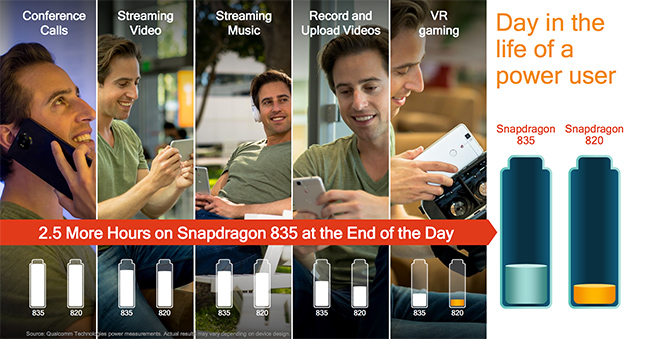The Qualcomm Snapdragon 835 Performance Preview
by Matt Humrick & Ryan Smith on March 22, 2017 4:30 AM EST- Posted in
- Smartphones
- Snapdragon
- Qualcomm
- Mobile
- SoCs
- Snapdragon 835
- Kryo
First Thoughts
Mobile SoCs are packed with specialized processors: CPU, GPU, high-performance DSP (compute), low-power DSP (sensor hub), modem DSP (signal processing), ISP (image processing), fixed-function blocks (video, audio), etc. And while all of these pieces contribute to the overall user experience, some of them are difficult to quantify. The CPU and GPU remain vital to device performance and battery life, so it’s still important to probe their capabilities.
Our initial testing shows that Snapdragon 835’s Kryo 280 CPU is an octa-core, big.LITTLE configuration with four semi-custom A73 “performance” cores and four semi-custom A53 “efficiency” cores. Kryo 280’s performance cores are pretty much equivalent to Kirin 960’s A73 cores in both integer and floating-point IPC, but comparing them to Snapdragon 820’s Kryo CPU shows mixed results: integer IPC improves but floating-point regresses.
In our limited system testing, the Snapdragon 835’s IPC gains outweigh its losses, providing better overall performance than the Snapdragon 820/821 phones. Unsurprisingly, the Snapdragon 835 MDP/S matched the performance of the Mate 9’s Kirin 960, which may not sound all that exciting, but considering our positive experience with the Mate 9, it’s certainly not bad either.
Qualcomm continues to push hard into VR/AR, not just with smartphones but stand-alone HMDs too. The high resolution and low latency requirements for these experiences suddenly make the GPU a bottleneck once again. The Snapdragon 835’s updated Adreno 540 GPU, through a combination of microarchitecture tweaks and a higher peak operating frequency, is another evolutionary step along the VR path, delivering a 25% peak performance boost over Snapdragon 820’s Adreno 530.
As noted earlier, all of these results came from pre-production hardware and software that’s under Qualcomm’s control, so performance could still go up or down once retail units begin shipping; however, based on these preliminary numbers and feature additions, the Snapdragon 835 looks like a solid evolutionary upgrade over the S820. The one glaring omission in this initial assessment, though, is power efficiency, which is critical to both battery life and sustained performance. The potential power savings from the move to 10nm and the CPU swap could have a larger impact on user experience than the small performance gains and new features.













128 Comments
View All Comments
joms_us - Saturday, March 25, 2017 - link
And your iPhone with its pathetic 720 display looks crap and sluggish as hell in real world comparison.IlllI - Saturday, March 25, 2017 - link
AMD really missed the boat when they sold their mobile assets to Qualcomm. I often wonder what AMD could have done if they had invested in developing mobile tech all these yearsrealbabilu - Sunday, March 26, 2017 - link
Maybe will be the same as Intel atom mobile did.IlllI - Sunday, March 26, 2017 - link
intel tried years after all these other companies got established. If AMD had gotten in earlier, instead of selling off to Qualcomm, AMD might be Qualcomm todayajohntee - Wednesday, April 12, 2017 - link
Not very possible. Qualcomm is where it's at today because of its early involvement with the CDMA technology and the subsequent development of great Modem chips. They could spend R&D money on their own GPU and cores because of the money coming from selling the whole package including the modem. AMD never had it and seeing how nVidia is struggling still with mobile chips, it's unlikely AMD would've fared much better.SyukriLajin - Thursday, March 30, 2017 - link
regarding 3QA. i'm wondering if it requires special [hardware/firmware] support to use FDD and TD LTE together, or 3QA, by default, supports combining both types of LTE? (this is of course assuming all the other hardware requirement supports 3QA, and the carrier operates on both TD and FDD LTE. I'm wondering because one of the carrier in my country talked about combining both types to get the highest speed, but provides no info if any of the current phone will support it.peevee - Tuesday, April 18, 2017 - link
Why would not you just test Firefox everywhere? Better yet, Firefox with AdBlock installed, so the ads would be uniformly eliminated form the sites. This would allow to compare performance of iPhone hardware. Although the Safari test is also useful as it demonstrates more real life experience of iPhone users which is years ahead of even future Android phones unfortunately.Hrel - Sunday, October 29, 2017 - link
Memory copy, it shows the 821 as being faster yet you have it marked as negative and in red. Yet it's about twice as much bandwidth/second. So, the 821 is really superior in all the areas where it matters, camera performance, speech recognition and memory copy. I'd say the 835 is a pretty big failure. I'll be skipping that SOC entirely.Fix your article though yo.